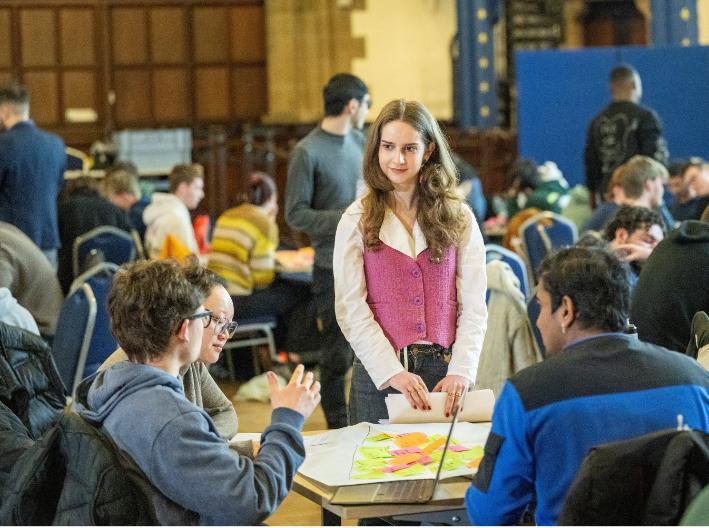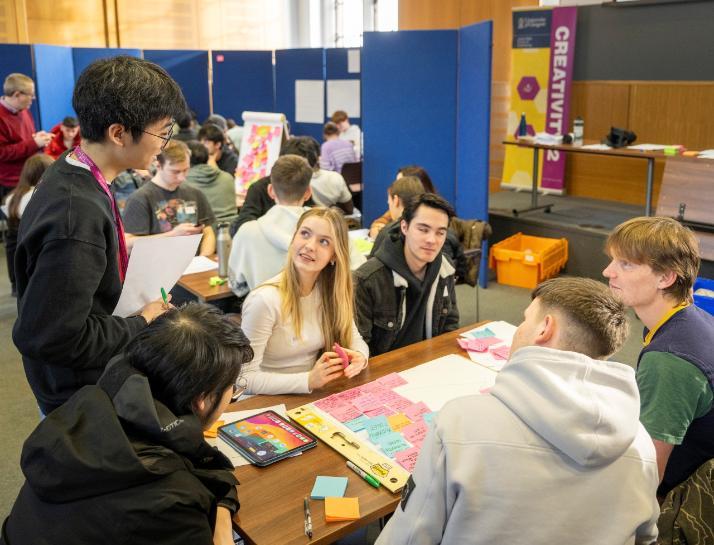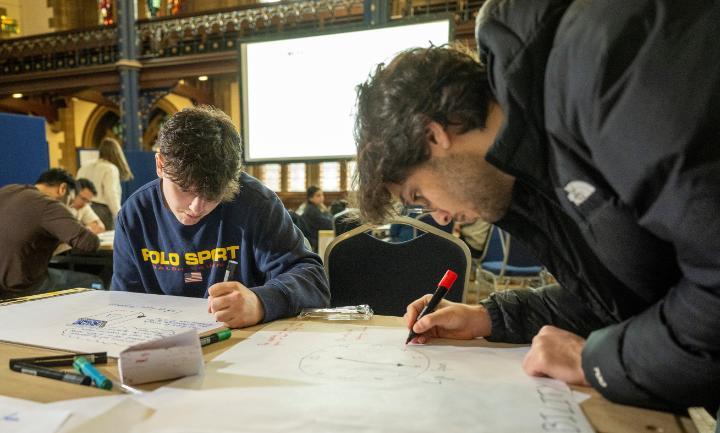
Surfacing skills… in a week-long team-based project: Creativity 2 Bootcamp
|
Title of case study |
Surfacing skills… in a week-long team-based project: Creativity 2 Bootcamp |
|
School/Subject:
|
James Watt School of Engineering |
|
Lecturer(s): |
Sandy Cochran, Kevin Worrall, Gilles Bailet, Guanchen Li, Lucas Ferrari Gerez, Khiem Nguyen |
|
Course: |
ENG2077 Engineering Skills 2 |
|
Student Level: |
Year 2 Engineering Students |
|
Class size: |
507 |
|
Location: |
Bute Hall and Senate Room |
Brief summary
Creativity 2 Bootcamp is a one-week, high-intensity multidisciplinary event for more than 500 second-year engineering students from across all engineering programmes. Over the course of the week, students organised in morning and afternoon cohorts , work within larger “companies” and smaller “teams” to apply the Double Diamond design process to global engineering challenges. The structure combines inspirational talks with guided creativity exercises and peer-assessed poster presentations. The emphasis is on exploring problems thoroughly, generating innovative solutions, and presenting ideas engagingly and persuasively.
Objectives
The main aim of the course is to develop creative problem-solving skills, with a particular focus on the “discover” and “define phases” of the double diamond model. It aims to spark collaboration across different engineering disciplines, encouraging students to approach problems from multiple perspectives. Students are guided to think innovatively about real-world global challenges while also integrating development of skills such as estimation, sketching, ethics, and sustainability. Another key objective is to build confidence in communicating and pitching engineering ideas.
What is done?
At the start of the week, students are grouped into companies and assigned a global challenge area such as personal mobility, wearable technologies, or food and drink. Each company is further divided into teams, which work through a structured series of activities: identifying a key problem, generating and clustering ideas, refining concepts, and evaluating feasibility and impact. The best ideas from each team are selected at the company level and developed collectively into a single refined solution. This solution is explored from multiple perspectives (concept, feasibility, impact, human factors, and sustainability), each of which is presented as a handmade poster. The week concludes with poster presentations, peer and mentor assessment, and the awarding of prizes to the top-performing companies.
What works well?
The immersive format of the bootcamp generates a high level of energy and focus among participants. The Double Diamond model offers a clear and effective framework for guiding creative thinking, and the multidisciplinary composition of teams allows exchange of perspectives. Inspirational guest speakers add excitement and ambition to the experience, and the use of peer assessment fosters constructive dialogue between teams. The requirement to create physical, artisan-style posters helps students develop visual communication skills in a way that differs from digital work and encourages hands-on creativity.
Benefits (students & staff)
For students, the bootcamp provides valuable experience in teamwork, interdisciplinary collaboration, and effective communication. It aims to equip them with a structured approach to creative thinking and problem framing while exposing them to important global challenges and ethical dimensions of engineering. It also gives them the opportunity to practice persuasive pitching in a supportive environment.
For staff, the course offers an engaging way to interact with students, promoting active learning and building connections across different programmes. It also fosters collaboration among academic, technical, and administrative staff in delivering a large, complex and multifaceted event.
Challenges (students & staff)
For students, the most significant challenges include managing the high workload, adapting quickly to working with new peers, and balancing creativity with practical feasibility. The requirement to produce posters without relying on digital tools is also demanding.
For staff, the scale of the event presents logistical challenges, from coordinating venues and materials to scheduling, assessment and tracking of individual student participation. Ensuring consistent quality of mentoring across many companies and maintaining student engagement throughout the week also requires careful planning and attention.
What did you learn?
A key lesson from delivering the Creativity 2 event is the importance of clear problem framing. Skipping or rushing through the early stages of the Double Diamond risks directing creativity towards the wrong problem. The structured processes of idea generation, clustering, and iterative refinement consistently produce stronger and more original solutions than unstructured brainstorming. The multidisciplinary nature of the teams also generates valuable insights. Students are particularly responsive to tangible, hands-on tasks and to seeing the direct relevance of their work to real-world issues.
What advice would you give to others?
Those planning a similar course should strike a balance between structure and creative freedom. Strong logistical planning is essential, including well-organised venues, materials, schedules, and mentor preparation. Inviting high-profile or inspiring speakers at the start can set a positive and ambitious tone. Peer-to-peer assessment can be highly effective in encouraging deeper engagement, while activities should balance open-ended creativity with an awareness of feasibility. It is also important to provide moments for reflection so that students can connect the skills they develop during the bootcamp to their wider engineering studies and professional aspirations.

A company mentor listens to an explanation of progress.

A team explains their work to their company mentor.

A creativity 2 student team prepares their poster for the final presentation.


